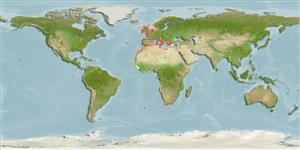Common names from other countries
Environment: milieu / climate zone / depth range / distribution range
Ecologie
Rifbewoner. Subtropical
Eastern Atlantic and the Mediterranean.
Length at first maturity / Size / Gewicht / Leeftijd
Maturity: Lm ? range ? - ? cm
The stony coral are not colonial. Vertical size skeleton reaches 0.25 mm, its section is round; at base not narrowed in normal conditions. End of the tentacles forming a small spherical bludgeon brown; white or pink polyps (Ref. 358).
Vertical skeleton size: 0.25 cm (Ref. 358). Habitat: Interior of underwater caves and anfractuosities, lower level of rock overhangs, bottom and walls of rock nature little exposed to the light species present of the small funds until greater depth (Ref. 358). Known from infra- and circalittoral zones (Ref. 85338).
Life cycle and mating behavior
Geslachtsrijpheid | Voortplanting | Kuitschieten | Eieren | Fecundity | Larven
Members of the class Anthozoa are either gonochoric or hermaphroditic. Mature gametes are shed into the coelenteron and spawned through the mouth. Life cycle: The zygote develops into a planktonic planula larva. Metamorphosis begins with early morphogenesis of tentacles, septa and pharynx before larval settlement on the aboral end.
Göthel, H. 1992. (Ref. 358)
Status op de Rode Lijst van het IUCN (Ref. 130435)
Status bij CITES (Ref. 108899)
Not Evaluated
Gebruik door de mens
| FishSource |
Tools
Internet-bronnen
Estimates based on models
Preferred temperature
(Ref.
115969): 10.5 - 18.3, mean 12.2 (based on 114 cells).
Prijsklasse
Unknown.
